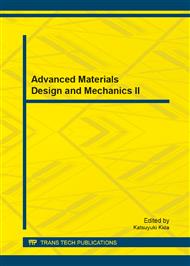[1]
Z. Harun, M. F. Shohur, M. Z. Yunos, M. R. Jamalludin, and A. F. Ismail, The Effect of Crystalline Rice Husk Silica on Polysulfone Membrane for Wastewater Treatment, Adv. Mat. Res. 328 (2013) 798–801.
DOI: 10.4028/www.scientific.net/amm.328.798
Google Scholar
[2]
Z. Harun, M. R. Jamalludin, M. Z. Yunos, M. F. Shohur, and A. F. Ismail, The Effect of Amorphous Rice Husk Silica to the Polysulfone Membrane Separation Process, Adv. Mat. Res. 701(2013) 319–322.
DOI: 10.4028/www.scientific.net/amr.701.319
Google Scholar
[3]
M. Z. Yunos, Z. Harun, H. Basri, and A. F. Ismail, Effects of Water as Non-Solvent Additive on Performance of Polysulfone Ultrafiltration Membrane, Adv. Mat. Res. 488–489 (2012) 46–50.
DOI: 10.4028/www.scientific.net/amr.488-489.46
Google Scholar
[4]
A. Idris, I. Ahmed, and M. A. Limin, Influence of lithium chloride, lithium bromide and lithium fluoride additives on performance of polyethersulfone membranes and its application in the treatment of palm oil mill effluent, Desalination. 25 (2010).
DOI: 10.1016/j.desal.2008.11.046
Google Scholar
[5]
A. Rahimpour, S. S. Madaeni, and Y. Mansourpanah, Fabrication of polyethersulfone (PES) membranes with nano-porous surface using potassium perchlorate (KClO4) as an additive in the casting solution, Desalination. 258 (2010) 79–86.
DOI: 10.1016/j.desal.2010.03.042
Google Scholar
[6]
Kang Li., Ceramic membrane for separation and Reaction, John Wiley and sons, West Sussex, (2007).
Google Scholar
[7]
N.F. Ismail, Z. Harun, N.A. Badarulzaman, A Comparative Study of Double Layers Al2O3/Al2O3 and Al2O3/SiO2 Prepared By Microwave and Natural Drying, International Journal of Integrated Engineering, 4 (2012) 16-21.
Google Scholar
[8]
Z. Harun, N. F. Ismail, N. A. Badarulzaman, Effect of MgO Additive on Microstructure of Al2O3, Adv. Mat. Res. 488 – 489 (2012) 335-33.
Google Scholar
[9]
Drioli, E. and L. Membrane Operations, Wiley, (2009).
Google Scholar
[10]
D. B. Mosqueda-Jimenez, R. M. Narbaitz, T. Matsuura, G. Chowdhury, G. Pleizier, and J. P. Santerre, J. Membr. Sci. 231 (2004) 209–224.
DOI: 10.1016/j.memsci.2003.11.026
Google Scholar
[11]
J. Bumsuk, Y.J. Ki, K. Bokyung, R. Hee-Woo, Effect of crystallization and annealing on polyacrylonitrile membranes for ultrafiltration, J. Membr. Sci. 246 (2005) 67–76.
Google Scholar
[12]
M. Wang, L. Wu, and C. Gao, The influence of phase inversion process modified by chemical reaction on membrane properties and morphology, J. Membr. Sci. 270 (2006) 154–161.
DOI: 10.1016/j.memsci.2005.06.051
Google Scholar
[13]
S. Yang and Z. Liu, Preparation and characterization of polyacrylonitrile ultrafiltration membranes, J. Membr. Sci. 222 (2003) 87–98.
Google Scholar
[14]
G. Arthanareeswaran, D. Mohan, and M. Raajenthiren, Preparation and performance of polysulfone-sulfonated poly(ether ether ketone) blend ultrafiltration membranes. Part I, Applied Surface Science. 253 (2007) 8705–8712.
DOI: 10.1016/j.apsusc.2007.04.053
Google Scholar
[15]
J. -H. Kim and K. -H. Lee, Effect of PEG additive on membrane formation by phase inversion, J. Membr. Sci. 138 (1998) 153–163.
DOI: 10.1016/s0376-7388(97)00224-x
Google Scholar
[16]
B. Chakrabarty, A. K. Ghoshal, and M. K. Purkait, Effect of molecular weight of PEG on membrane morphology and transport properties, J. Membr. Sci. 309 (2008) 209–221.
DOI: 10.1016/j.memsci.2007.10.027
Google Scholar
[17]
E. Yuliwati, A. F. Ismail, T. Matsuura, M. A. Kassim, and M. S. Abdullah, Effect of modified PVDF hollow fiber submerged ultrafiltration membrane for refinery wastewater treatment, Desalination, 283 (2011) 214–220.
DOI: 10.1016/j.desal.2011.03.049
Google Scholar
[18]
N. A. A. Hamid, A. F. Ismail, T. Matsuura, A. W. Zularisam, W. J. Lau, E. Yuliwati, and M. S. Abdullah, Morphological and separation performance study of polysulfone/titanium dioxide (PSF/TiO2) ultrafiltration membranes for humic acid removal, Desalination, 273(2011).
DOI: 10.1016/j.desal.2010.12.052
Google Scholar



